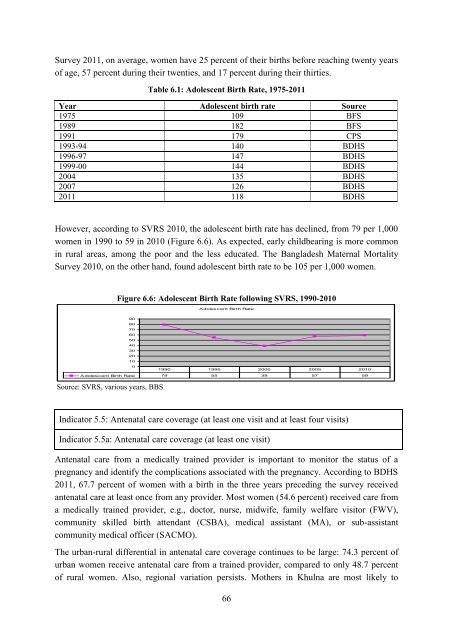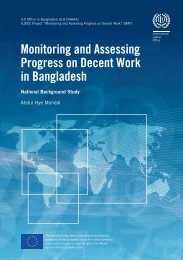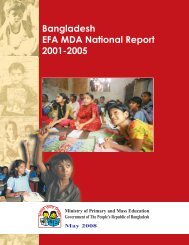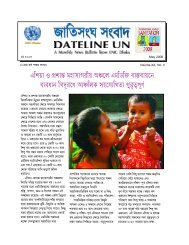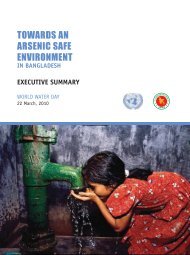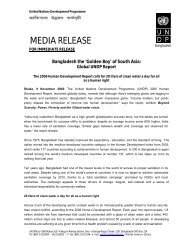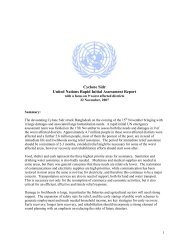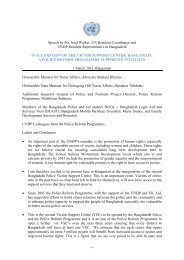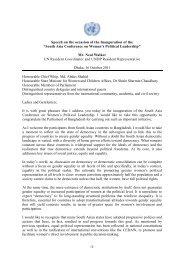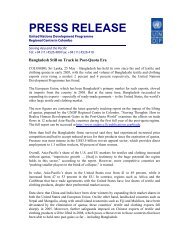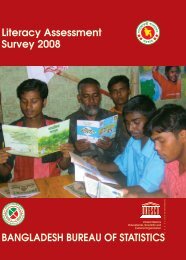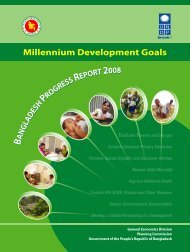MDG Report 2012 - United Nations in Bangladesh
MDG Report 2012 - United Nations in Bangladesh
MDG Report 2012 - United Nations in Bangladesh
- No tags were found...
Create successful ePaper yourself
Turn your PDF publications into a flip-book with our unique Google optimized e-Paper software.
Survey 2011, on average, women have 25 percent of their births before reach<strong>in</strong>g twenty yearsof age, 57 percent dur<strong>in</strong>g their twenties, and 17 percent dur<strong>in</strong>g their thirties.Table 6.1: Adolescent Birth Rate, 1975-2011Year Adolescent birth rate Source1975 109 BFS1989 182 BFS1991 179 CPS1993-94 140 BDHS1996-97 147 BDHS1999-00 144 BDHS2004 135 BDHS2007 126 BDHS2011 118 BDHSHowever, accord<strong>in</strong>g to SVRS 2010, the adolescent birth rate has decl<strong>in</strong>ed, from 79 per 1,000women <strong>in</strong> 1990 to 59 <strong>in</strong> 2010 (Figure 6.6). As expected, early childbear<strong>in</strong>g is more common<strong>in</strong> rural areas, among the poor and the less educated. The <strong>Bangladesh</strong> Maternal MortalitySurvey 2010, on the other hand, found adolescent birth rate to be 105 per 1,000 women.Figure 6.6: Adolescent Birth Rate follow<strong>in</strong>g SVRS, 1990-2010Adolescent Birth Rate90807060504030201001990 1995 2000 2005 2010Adolescent Birth Rate 79 55 39 57 59Source: SVRS, various years, BBSIndicator 5.5: Antenatal care coverage (at least one visit and at least four visits)Indicator 5.5a: Antenatal care coverage (at least one visit)Antenatal care from a medically tra<strong>in</strong>ed provider is important to monitor the status of apregnancy and identify the complications associated with the pregnancy. Accord<strong>in</strong>g to BDHS2011, 67.7 percent of women with a birth <strong>in</strong> the three years preced<strong>in</strong>g the survey receivedantenatal care at least once from any provider. Most women (54.6 percent) received care froma medically tra<strong>in</strong>ed provider, e.g., doctor, nurse, midwife, family welfare visitor (FWV),community skilled birth attendant (CSBA), medical assistant (MA), or sub-assistantcommunity medical officer (SACMO).The urban-rural differential <strong>in</strong> antenatal care coverage cont<strong>in</strong>ues to be large: 74.3 percent ofurban women receive antenatal care from a tra<strong>in</strong>ed provider, compared to only 48.7 percentof rural women. Also, regional variation persists. Mothers <strong>in</strong> Khulna are most likely to66


